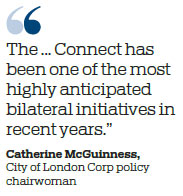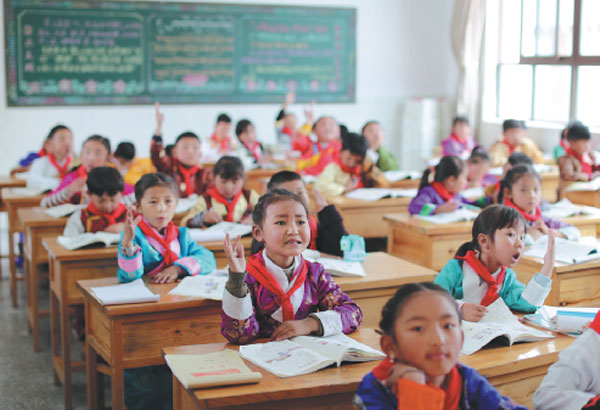Tibet flourishes as development continues
Editor's note: This year marks the 70th anniversary of the founding of the People's Republic of China. This is part of a series looking at the significant developments in various fields as China increases its interactions with the world.
Dawa Chok, 47, remembers how, less than a decade ago, he had to cover long distances to find jobs in urban areas.
"Sometimes I had to travel up to half a day just to get any sort of manual work," he said.
Those difficult days are now over for the Tibetan in Lunang, a town in the southeastern city of Nyingchi in the Tibet autonomous region.
Dawa Chok runs a family inn that caters to tourists in the village of Tashigang, which is lauded as a model for one of the region's pillar industries, tourism, which benefits from transportation and other infrastructure development.
Tashigang is along National Highway 318, a crucial link that connects the regional capital of Lhasa with Chengdu, the capital of neighboring Sichuan province.
The local government has said the village epitomizes the lush and pristine environment of Nyingchi and offers a model for pioneering economic growth through tourism. More than 60 Tashigang households and over 300 residents are now involved in the sector, with more than 50 family inns like Dawa Chok's, which together offer more than 1,200 beds, according to the regional government.
Last year, the village received more than 75,000 tourists, adding 4.06 million yuan ($586,000) to tourism revenue.
Dawa Chok makes about $14,400 a year from his 18-bed inn, which also houses his four-generation family of nine.
Local government employee Tsering Drolma helps coordinate training and support for residents like Dawa Chok.
"By working with the local authorities to better tap and promote tourism, drawing people from all over the country and abroad here, it is definitely making a difference in local lives," Tsering Drolma said.
"Infrastructure developments, like the airport in Nyingchi and the main 318 highway passing through the area, will improve and build on that. Other forms of major building projects will be very welcomed," she said.
At an international forum on the development of Tibet in Lhasa on Friday, the achievements attained in recent decades by the opening-up of the region and its increased interactions with the rest of the world were also held up as important steps in its continued development.
Qi Zhala, chairman of the regional government, said increased infrastructure building and networks that tap cooperation with neighboring countries such as Nepal would also be given priority to push growth.
"We will continue to improve trade with neighboring countries.... We will also promote Tibetan culture and tourism," he said.
Opening-up helped power regional GDP to a high of more than $21 billion last year. Per capita disposable income of urban residents hit $4,907, a year-on-year increase of 10.2 percent, and that of rural residents reached $1,653, a year-on-year rise of 10.8 percent, according to the regional government.
The transportation sector alone drew fixed asset investment of $7.5 billion last year, helping to stretch the region's roads to 89,000 kilometers, the government said.
Major transportation links - including the Qinghai-Tibet Railway, which stretches nearly 2,000 km and connects Tibet with neighboring Qinghai province - have significantly boosted Tibet's tourism sector.
Last year, the autonomous region drew more than 33 million visitors, reaping more than $7.07 billion in tourism revenue, compared with the region's 1.8 million visitors and about $274 million in revenue in 2005, the year before the railway's launch, according to figures from the regional government.
Shen Bing, deputy director of the Institute of Land Development and Regional Economy of the National Development and Reform Commission, the country's top economic planner, said Tibet is also an important gateway to South Asia. Tibet's trade volume hit more than $700 million last year, with trade with Nepal accounting for more than half of the autonomous region's foreign trade and rising 4.6 percent year-on-year, according to regional government figures.
"Tibet is located in the southwestern frontier of China and borders on countries like Nepal and India ... giving full play to the unique geographical and other advantages of the region, such as promoting infrastructure building and opening-up to South Asia," Shen said.
Such factors "will not only expand economic and social development, but will also promote the better integration of Tibet with the world", she added.
Forum participants also focused on the China-proposed Belt and Road Initiative as a significant part of Tibet's opening-up.
Vjaceslavs Dombrovskis, a former Latvian government minister who is chairman of a Latvian group that promotes cooperation with China, said it was "highly symbolic" that the forum was held in Tibet, which historically had an important role in East-West trade and was the gateway to South Asia. "The vision of the Belt and Road Initiative is to provide Tibet with the connection not only to the country's eastern coastal areas, but also with Nepal and ultimately India," Dombrovskis said.
Zolboo Dashnyam, the director of Mongolia's Institute of International Affairs research center at the Mongolian Academy of Sciences, moderated a group discussion at the forum, focusing on the role of Tibet in the BRI.
Tibet, with its vast area and geography, was in many respects similar to Mongolia, and something as fundamental as roads helped form the foundation of the region's development, he said.

"The infrastructure links are certainly important for improving livelihoods, as we're seeing on the ground in terms of tourism development," he said.
Niklas Swanstrom, the director of the Stockholm-based Institute for Security and Development Policy, said more diversified investment in local businesses was also fundamental to the long-lasting development of the region.
The need for Tibet's "green development" through environmental sustainability is also a hot topic, including awareness of the possibility of melting permafrost on the region's plateau affecting investment projects, he said.
"I do remain optimistic of positive outcomes.... What we need to do is to maintain the focus and push for a bright future," Swanstrom said.
Paul Tembe, senior researcher at South Africa's Thabo Mbeki African Leadership Institute, said Tibet offered an attractive example of attaining "harmonious development" that encompassed tradition and technological progress.
In the town of Lunang, the development push is gearing up through an international tourism hub project that taps the region's distinctive ethnic heritage. With an investment of more than $560 million, the complex covers more than 85 hectares, according to the local government. The area has a combined capacity of more than 2,200 beds for visitors, while facilities such as a museum will help preserve ethnic customs.
"Tourism is a pillar of the economy, and Lunang is poised to be a major draw in the region," said Xie Binhui, deputy director of the Lunang management committee.
For Lunang family inn owner Dawa Chok, the satisfaction he derives from hosting tourists comes not just from the money they bring in, but also from his interactions with them.
"I get to meet people from all over," he said. "We share our experiences and customs, and I can know more about the world through them."
alexishooi@chinadaily.com.cn
|
Students attend class at a primary school in Nyingchi, Tibet autonomous region, early this month.Wang Jing / China Daily |
(China Daily Global 06/18/2019 page1)



















